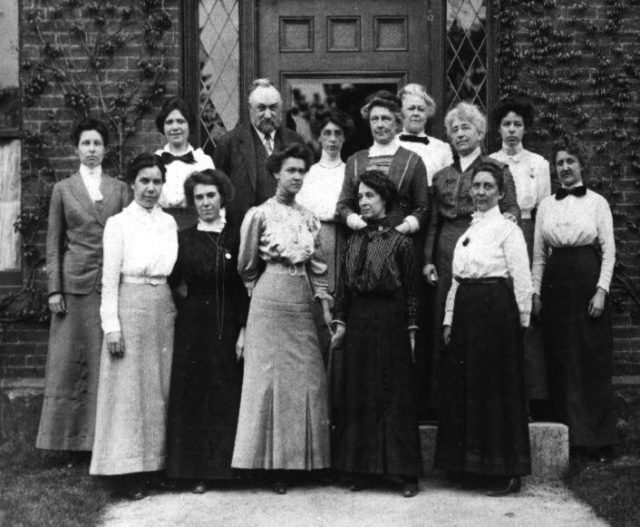In the late 1800s, a group of women hunched over their desks in Cambridge, Massachusetts, as they cataloged hundreds of thousands of stars using a system they invented. They worked six days a week making calculations that would eventually inform the discovery of the universe’s expansion. They came to be known as the “Harvard Computers,” but at the time these obviously very intelligent ladies were not allowed to vote.
Edward Charles Pickering, the fourth director of the Harvard Observatory, was a progressive man for his times. He graduated from Harvard in 1865 and taught physics at MIT, where he bucked tradition by allowing students to participate in experiments. He invited women to attend his lectures.
Instead of relying on observations by telescope, Pickering encouraged examination of astro-photographs. In the late 1800s, new glass-plate technology allowed astronomers to take photographs through a telescope. Pickering’s ambition was to examine and catalogue the whole night sky. The Harvard College Observatory amassed a huge collection of images, which eventually numbered a half-million glass plates.
There was, however, a problem: more data coming in via photographs than the available eyes could analyze. The clerical work was tedious, exacting, and repetitive. It also required thoughtful, attentive skill. That’s how, when, and why Pickering turned to women.
In 1881, on the recommendation of his wife, Pickering first hired one of the maids of his household, Williamina Fleming. She would work for at Harvard for 34 years, becoming the manager of a large staff of assistants.
Pleased with Fleming’s obvious intelligence and work ethic, Pickering wrote an ad recruiting other women, as recounted in The Glass Universe: How the Ladies of Harvard Universe Took the Measure of the Stars, by Dava Sobel. “Many ladies are interested in astronomy and own telescopes, but with two or three noteworthy exceptions their contributions to the science have been almost nothing,” Pickering wrote, as Sobel recounts. “Many of them have the time and inclination for such work, and especially among the graduates of women’s colleges are many who have had abundant training to make excellent observers. As the work may be done at home, even from an open window, provided the room has the temperature of the outer air, there seems to be no reason why they would not thus make an advantageous use of their skill.”

More than 80 women would work for Pickering during his tenure, which lasted until 1918. They came to be called the “Harvard Computers.” Some men, compelled to be dismissive of the women’s intellectual prowess, condescendingly called them “Pickering’s harem.” And Pickering’s motives weren’t entirely altruistic: The women pored over photographs six days a week, earning 25 to 50 cents an hour—about half a man’s wage.
The work was a grind, as described by Smithsonian magazine: “Some of the women would reduce the photographs, taking into account things like atmospheric refraction, in order to render the image as clear and unadulterated as possible. Others would classify stars through comparing the photographs to known catalogs. Others cataloged the photographs themselves, making careful notes of each image’s date of exposure and the region of the sky. The notes were then meticulously copied into tables, which included the star’s location in the sky and its magnitude.”
While the women were discouraged from doing any theorizing themselves, the work they were doing would become the basis for astronomical theory. “Women computers cataloged stars for the Henry Draper Catalogue, discovered variable stars, studied stellar spectra and counted galaxies, to name a few of their duties,” according to the Harvard College Observatory.
A few of them even became famous astronomers in their day.
By 1890, Fleming had singlehandedly classified the spectra of 10,000 stars, published the findings in The Draper Catalogue, and proofread all 400 pages. On May 11, 1906, she received “perhaps the most pleasant shock of her life,” as Sobel wrote: Fleming was elected honorary member of the Royal Astronomical Society.
Annie Jump Cannon, a Wellesley and Radcliffe student, found Pickering’s and Fleming’s cataloging system unusable and so devised her own classification system employing alphabetization. She catalogued more than 20,000 stars shortly after joining the computers. Her methodology, adopted by the International Astronomical Union in 1922, is still in use today. Keen observers will note it is called the Harvard Spectral Classification Scheme, not the Cannon system.
Cecilia Payne, the first person to earn a Harvard-Radcliffe Ph.D. in astronomy, discovered the sun was made largely of hydrogen. Henrietta Swan Leavitt’s discoveries became the basis of Hubble’s Law, which demonstrates the expansion of the universe.
Related story from us: Hidden Figures: The stories of three extraordinary women from NASA
Pickering retired in 1918 and died a year later. Cannon continued working at Harvard. In 1938 she was at last appointed an official astronomer at the college.
The Harvard Plate Collection continued until 1992, when it became supplanted by more advanced technologies. The catalogue is being digitized, but the archives remain available for study.
E.L. Hamilton has written about pop culture for a variety of magazines and newspapers, including Rolling Stone, Seventeen, Cosmopolitan, the New York Post and the New York Daily News. She lives in central New Jersey, just west of New York City
